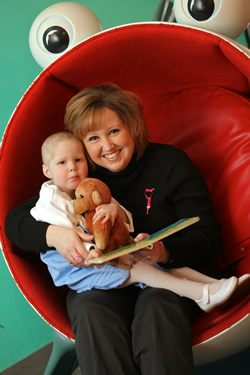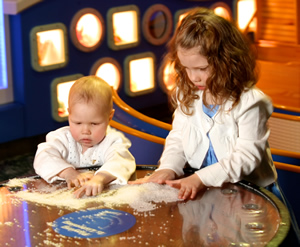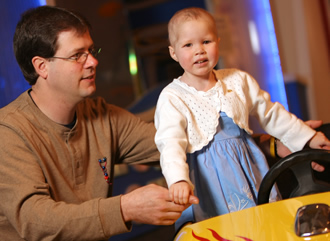Miracle Kids: Hailey Coniber
Optimism and Team Work Win Toddler’s War with Cancer
 Toddlers don’t usually come out of the operating room (OR) with an idea for a Halloween costume, but Hailey Coniber is no typical toddler. Over the past year, the 3-year-old has been through half a dozen surgeries and many more hospital visits, and yet her optimism and curiosity have prevailed over what might have otherwise seemed like a dire situation.
Toddlers don’t usually come out of the operating room (OR) with an idea for a Halloween costume, but Hailey Coniber is no typical toddler. Over the past year, the 3-year-old has been through half a dozen surgeries and many more hospital visits, and yet her optimism and curiosity have prevailed over what might have otherwise seemed like a dire situation.
At the beginning of February 2009, Hailey’s mom, Melissa, noticed a very subtle anomaly on her 2-year-old. A few tiny hairs had cropped up around Hailey’s pubic area. Melissa took Hailey to see their local pediatrician in Leroy, who recommended they visit Nicholas Jospe, M.D., chief of Pediatric Endocrinology at Golisano Children’s Hospital at the University of Rochester Medical Center.
Jospe determined that Hailey had an overactive adrenal gland, which was causing precocious puberty, and a CT scan later revealed that Hailey had an apple-sized tumor on her left adrenal gland. Jospe referred the Conibers to Walter Pegoli, M.D., chief of Pediatric Surgery at Golisano Children’s Hospital. Two days later, the family met with Pegoli in preparation for the removal of the tumor.
The surgery, which took place April 8, was expected to last four hours. Forty-five minutes after the operation began, the Conibers ran into a few of the nurses who had been in the OR with Pegoli. “Oh, we’re done!” said one of the nurses. Pegoli met with the family after he had scrubbed out and informed them that he had excised, or taken out, the entire tumor and the affected adrenal gland. He said that while the likelihood of the tumor being cancerous was less than 1 percent, they were going to run it through pathology to be sure.
Unfortunately, the test was positive for cancer.
“It’s extremely rare that an adrenal gland has a cortical tumor, which is cancerous, as opposed to a neurogenic tumor, which tends to be benign” said Pegoli. “I’ve only seen two of these cases in my 20-year career.”
Hailey went home the day before Easter but ended up back that same day to be treated for ileus – an intestinal blockage that can occur after abdominal surgery – so Melissa and Jason brought their daughter back for another CT scan. The scan picked up two spots on Hailey’s right lung. Since it was difficult to tell at that point whether the spots were cancerous, Melissa and Jason were advised to monitor Hailey and to come back three weeks later to see if the spots had grown.
When the family returned for the next CT scan, it appeared that Hailey’s spots might be cancerous lesions. A couple days later, Hailey had her second surgery, on May 29, Pegoli performed a thoracotomy – an incision into the pleural part of the chest to get access to the lungs. He resected, or removed, three lesions from Hailey’s right lung. Later, results from pathology showed that the lesions were consistent with Hailey’s original tumor, which meant the cancer had spread to her lungs.
One month later, on June 5, Hailey returned to the operating room yet again, this time to place a central venous line so Hailey could begin her vigorous cancer treatment. A central line is a catheter tube passed through a vein to the chest portion of the large vein that returns blood to the heart.
A few days later, the Conibers began meeting with Lauren Bruckner, M.D., Ph.D., assistant professor of Pediatrics and Oncology at Golisano Children’s Hospital, for Hailey’s chemotherapy treatment. It was important to both the family and pediatric oncologist that they develop a strong working relationship.
“We talk about how the care of a child with cancer is truly a partnership between the family and the child’s health care providers,” said Bruckner. “There isn’t a better example of this than the way in which Melissa and Jason have advocated for their daughter.”
Bruckner was struck by how thoroughly the Conibers prepared for appointments with questions and a list of Hailey’s medications and reactions to treatment. “Dr. Bruckner was very good about listening to us and looking through our notes with us,” said Melissa. “We felt almost bad bombarding her with questions.”
 Melissa and Jason took notes daily, and even hourly. Note-taking, as it turns out, was instrumental to Hailey’s treatment. Hailey was taking 24 medications to fight cancer and replace hormones that her body was no longer able to produce since her left adrenal gland had been removed. Hailey’s medications came with just as many side effects, all of which were carefully observed by her parents. Melissa and Jason got to the point where they could predict the timing of Hailey’s mood swings and reactions to her medications within the hour.
Melissa and Jason took notes daily, and even hourly. Note-taking, as it turns out, was instrumental to Hailey’s treatment. Hailey was taking 24 medications to fight cancer and replace hormones that her body was no longer able to produce since her left adrenal gland had been removed. Hailey’s medications came with just as many side effects, all of which were carefully observed by her parents. Melissa and Jason got to the point where they could predict the timing of Hailey’s mood swings and reactions to her medications within the hour.
Despite their diligence, Hailey began to run the other way when she saw her parents coming because she knew another dose of medication was coming with them. Her nausea, a side effect of the chemotherapy, also made it difficult for Melissa and Jason to persuade Hailey to eat.
The Conibers asked Bruckner and Pegoli about inserting a gastrostomy feeding tube that could supply Hailey with the medications and nourishment she needed. The tube, which looked like a button on the belly and would be surgically placed through the stomach into the abdominal wall, meant another surgery for little Hailey, but Bruckner and Pegoli agreed that it would make it easier to manage her treatment in the long run.
On August 11, Pegoli worked with the Division of Pediatric Gastoenterology to insert a feeding tube. The decision proved to be beneficial for everyone involved. Hailey was getting everything she needed more easily and she no longer saw her parents as “the bad guys.” Hailey has since come to love her “tubey,” which looks like a Mickey Mouse button, as if it were always part of her.
During her many visits to the hospital, Hailey also came to adore her surgeon, “Dr. Goli.” When Halloween came around, she decided to dress up like her “boyfriend” and proudly sported a surgeon’s outfit when she went out trick-or-treating. The nurses on 4-3600 came to know and love the bright-eyed little girl who liked to sit with them at the nurses’ station.
“Hailey was pretty good about being her own advocate,” said Melissa. She described how Hailey learned how to unhook herself from IV tubes properly and always asked, “What’s this?” when nurses or doctors gave her a dose of medication.
Hailey’s positive outlook on her hospital experience reflected the kind, appreciative and receptive demeanor of her parents.
“You see the best in people and you see the worst in people when their children are sick,” said Pegoli. “Some parents take it out on providers, while others exercise such grace and dignity not only to rise to the occasion, but to rise above and think about others.”
Pegoli recalled that despite the difficult position Melissa and Jason found themselves in, they often brought candy and cookies in for the residents and nursing staff. The Conibers recognized that providers were doing their best to help their little girl and were grateful for it.
The Conibers worked with Pegoli and Bruckner to determine the best options for Hailey. A CT scan Oct. 28 showed that Hailey had another spot on her right lung. Pegoli suggested waiting to do the surgery, since Hailey was neutropenic, which meant she had an abnormally low number of neutrophils, an important white blood cell that fights off infections, and her platelet counts were also very low.
Pegoli told Melissa and Jason that with a blood transfusion, they could give Hailey the red blood cells and blood-clotting cells she needed to do the surgery to remove the lesions, but that Hailey would have a better chance at recovering if they waited until Hailey’s immune system had strengthened on its own. The Conibers agreed.
 “Dr. Pegoli was always honest and had very strong standards,” said Melissa, as she recounted the story, “I really admired that.”
“Dr. Pegoli was always honest and had very strong standards,” said Melissa, as she recounted the story, “I really admired that.”
After a few weeks, Hailey’s blood count levels were high enough for the surgery, which the family scheduled for November 12. Pegoli said he would do his best to remove the lesion, located in a hidden area of Hailey’s lung that was difficult to access. He removed the lesion, along with two other suspicious-looking spots.
After completing the six cycles of chemotherapy prescribed by Bruckner and the most recent surgery with Pegoli, there are no cancerous cells to be found in Hailey.
“I think we’re at the best possible place we could be right now,” said Bruckner. “We have no evidence of any disease.”
“It was a positive experience, thank goodness,” said Melissa, ever the optimist, “We’re still close with everyone. We still visit the nurses and see the doctors. Things happen and it stinks but so far, we’ve had a good outcome.”